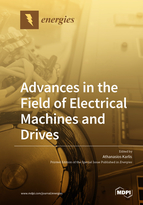Advances in the Field of Electrical Machines and Drives
A special issue of Energies (ISSN 1996-1073). This special issue belongs to the section "F: Electrical Engineering".
Deadline for manuscript submissions: closed (31 December 2021) | Viewed by 32925
Special Issue Editor
Interests: electrical machines and drives; diagnostics of electrical machines; renewable energies and smart grids
Special Issues, Collections and Topics in MDPI journals
Special Issue Information
Dear Colleagues,
The Guest Editors are inviting submissions for a Special Issue of Energies on the subject area of "Advances in the Field of Electrical Machines and Drives". Electrical machines and drives are dominating our everyday life, as they have numerous applications in industry, power production, home appliances, and transportation systems, e.g., electric or hybrid electric vehicles, ships, aircrafts, etc. Their development follows the rapid advances in science, engineering, and technology. Electrical machines and drives are being extensively investigated by researchers around the world due to their reliability, efficiency, performance, and fault-tolerant structure, with a focus on the importance of the integration of these new trends in their technology for energy saving and reduction of greenhouse gas emissions. This Special Issue aims to provide an opportunity for researchers to present their recent work on the advances in the field of electrical machines and drives. We welcome any article dealing with: new design trends of electrical machines and drives including special machines and their applications, new materials including the insulation of electrical machines; new trends in the diagnostics and condition monitoring; power electronics, control schemes, and algorithms for electrical drives; new topologies; and innovative applications.
Prof. Dr. Athanasios Karlis
Guest Editor
Manuscript Submission Information
Manuscripts should be submitted online at www.mdpi.com by registering and logging in to this website. Once you are registered, click here to go to the submission form. Manuscripts can be submitted until the deadline. All submissions that pass pre-check are peer-reviewed. Accepted papers will be published continuously in the journal (as soon as accepted) and will be listed together on the special issue website. Research articles, review articles as well as short communications are invited. For planned papers, a title and short abstract (about 100 words) can be sent to the Editorial Office for announcement on this website.
Submitted manuscripts should not have been published previously, nor be under consideration for publication elsewhere (except conference proceedings papers). All manuscripts are thoroughly refereed through a single-blind peer-review process. A guide for authors and other relevant information for submission of manuscripts is available on the Instructions for Authors page. Energies is an international peer-reviewed open access semimonthly journal published by MDPI.
Please visit the Instructions for Authors page before submitting a manuscript. The Article Processing Charge (APC) for publication in this open access journal is 2600 CHF (Swiss Francs). Submitted papers should be well formatted and use good English. Authors may use MDPI's English editing service prior to publication or during author revisions.
Keywords
- Rotating machines
- Special machines
- New design trends of electrical machines and drives
- New materials in electrical machines
- Diagnostics and condition monitoring
- Electrical drives
- New control schemes for electrical drives
- New power electronics for electrical drives
- New topologies of electrical machines and drives
- Innovative manufacturing techniques






